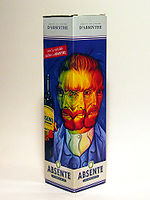
Absente
Encyclopedia

Anise
Anise , Pimpinella anisum, also called aniseed, is a flowering plant in the family Apiaceae native to the eastern Mediterranean region and Southwest Asia. Its flavor resembles that of liquorice, fennel, and tarragon.- Biology :...
liqueur
Liqueur
A liqueur is an alcoholic beverage that has been flavored with fruit, herbs, nuts, spices, flowers, or cream and bottled with added sugar. Liqueurs are typically quite sweet; they are usually not aged for long but may have resting periods during their production to allow flavors to marry.The...
that has been marketed under the tagline "Absinthe
Absinthe
Absinthe is historically described as a distilled, highly alcoholic beverage. It is an anise-flavoured spirit derived from herbs, including the flowers and leaves of the herb Artemisia absinthium, commonly referred to as "grande wormwood", together with green anise and sweet fennel...
Refined" since circa 2001. "Absente" is a French word that translates as "absent" in English.
In the U.S.
Prior to 2009, Absente sold in the U.S. contained no grande wormwood (Artemisia absinthium), the essential herb from which absinthe derives its name. The maker substituted southernwood (Artemisia abrotanumSouthernwood
Southernwood is a flowering plant. Found in Europe, the genus Artemisia was named for the goddess Artemis. Southernwood is known by many other names including Old Man, Boy's Love, Oldman Wormwood, Lover's Plant, Appleringie, Garderobe, Our Lord's Wood, Maid's Ruin, Garden Sagebrush, European Sage,...
) and the product was bottled with sugar, two critical aspects that differentiated Absente as an anise liqueur and not an absinthe by any traditional reference. The ingredients of Absente are listed in order as alcohol, sugar, a combination of "essences", infusions and distillates, and two artificial dyes, FD&C Yellow #5 and Blue #1.
Absente's U.S. marketing effort had long sought to associate the liqueur with traditional absinthe through statements such as, "The only difference is we replaced Wormwood...with a less bitter cousin called Southern-Wormwood, also known as "Petite Absinthe," which allows us to offer Absente in the United States." The reference to "petite absinthe" is inaccurate, as petite absinthe refers invariably to 'roman wormwood' (Artemisia pontica) throughout credible distillation treatises, while 'southernwood' is historically referred to as aurone, abrotone, or armoise citronelle, and is scarcely ever mentioned, if at all. At that time, Absente's website explained, "By maintaining a form of wormwood in Absente, we are able to truly call Absente a modern Absinthe."
Following the re-legalization of genuine absinthe in the U.S. in 2007, the North American importer introduced a reformulated version that includes grande wormwood (April, 2009) in an apparent effort to improve its consumer appeal. The new label proclaims, "Now With Wormwood!".
In Europe
The version marketed in EuropeEurope
Europe is, by convention, one of the world's seven continents. Comprising the westernmost peninsula of Eurasia, Europe is generally 'divided' from Asia to its east by the watershed divides of the Ural and Caucasus Mountains, the Ural River, the Caspian and Black Seas, and the waterways connecting...
under the same name is and has always been made with "essence of grande wormwood" (Artemisia absinthium). The label design differs mildly from the U.S. version by having "Liqueur aux Plantes d'Absinthe" above the main label and a silver capsule.

